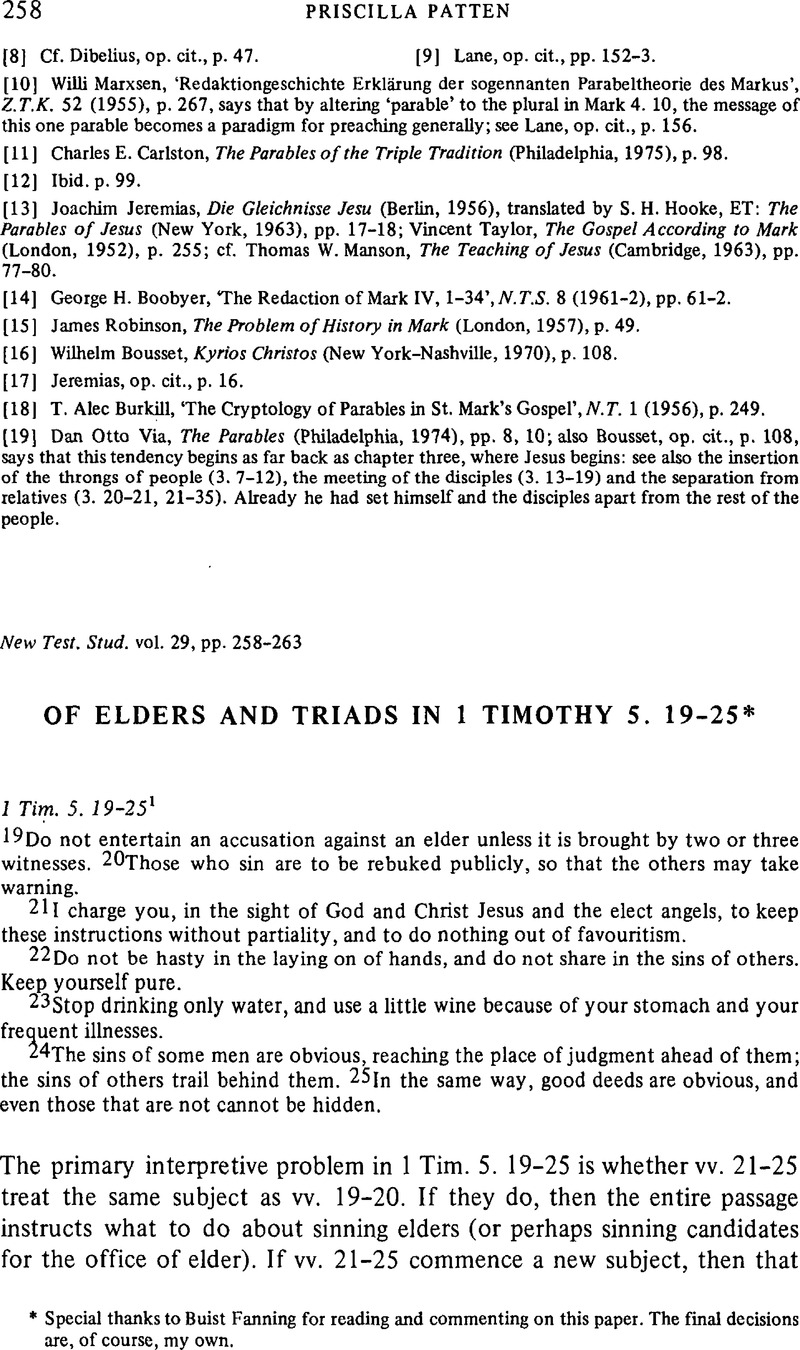Article contents
Of Elders and Triads in 1 Timothy 5. 19–25*
Published online by Cambridge University Press: 05 February 2009
Abstract

- Type
- Short Studies
- Information
- Copyright
- Copyright © Cambridge University Press 1983
References
Notes
[1] The New International Version.
[2] Galtier, P., ‘La réconciliation des pécheurs dans la première épître à Timothée’, Rech. Sc. Rel. 39 (1951), pp. 317–20.Google Scholar
[3] Lock, W., A Critical and Exegetical Commentary on the Pastoral Epistles, ICC (Edinburgh: T. and T. Clark, 1924), pp. 63–4.Google Scholar
[4] Dibelius, M. and Conzelmann, H., The Pastoral Epistles, Hermeneia Series (ed. Koester, H.; Philadelphia, Penn.: Fortress Press, 1972), p. 80.Google Scholar
[5] This kind of argumentation will be discussed subsequently.
[6] Chrysostom, Hom 16, wrote, ‘Having spoken of Bishops and Deacons … now he was speaking of judgment, he has added, “I charge thee before God and the Lord Jesus Christ and the elect angels …” He impresses Timothy with fear; after which he adds, what was most vital, and bears most on the maintenance of the Church, the matter of Ordinations. “Lay hands”, he says …’ Finally, Chrysostom introduced v. 24 with the words, ‘In speaking of ordination’.
[7] Jerome, Letter 27, ‘To Marcella’ 3, wrote, ‘… in the words of Scripture, “Against an elder receive not an accusation, but before two or three witnesses. Then that sin rebuke before all.”’ See also Letter 125, ‘To Rusticus’ 14.
[8] Van Vliet, H., No Single Testimony. A Study on the Adoption of the Law of Deut. 19:15 Par. into the New Testament, Studia Theologica 4 (ed. Obbink, H. W., van Ruler, A. A., van Unnik, W. C.; Utrecht, Holland: Kemink and Zoon, 1958), ftn. 630, p. 88. This author was unable to find the original quotes of Beza and Ambrosius.Google Scholar
[9] Kelly, J. N. D., A Commentary on the Pastoral Epistles, Black's New Testament Commentaries (London: Adam and Charles Black, 1963), p. 127.Google Scholar
[10] Adler, N., ‘Die Handauflegung im NT bereits ein Bußritus?’, Neutestamentliche Aufsätze, Festschrift für Prof. Josef Schmid (ed. Blinzler, J., Kuss, O., and Mußner, F.; Regensburg: Friedrich Pustet, 1963), pp. 1–6.Google Scholar
[11] Ibid., p. 2.
[12] Ibid., pp. 4–5.
[13] While not unimportant, arguments based on the predominance of usage are especially weak in the Pastorals, where departures from Pauline style, etc. are used by some scholars to support certain debatable points, whereas those same scholars rely on a presupposed similarity of style, etc. to prove other points! One cannot have both, though the problem really originates in the weakness of this kind of argumentation. In fact, the very problem confronted in this paper demonstrates that weakness. As noted earlier, Dibelius and Conzelmann came to one conclusion using an argument based on usage, and Adler came to an opposite conclusion using another argument based on usage. The point is, style is inconsistent, and to the degree that it is this kind of argumentation is equally inconsistent.
[14] Van Vliet, Testimony, pp. 1–6.
[15] This particular observation will be discussed in detail subsequently.
[16] One final problem which has been raised in regard to the suggested interpretation, is that in 1 Tim. 5. 18–19 ‘elder’ is singular, yet in v. 20 ‘sinners’ is plural, indicating that the subject has changed. However, in v. 17 ‘elders’ is indeed plural and, as Adler observes, the singular ‘elder’ in v. 19 is probably collective (‘Handauflegung’, p. 3).
[17] The relationship between v. 23 and its context is problematic regardless of which interpretation is taken. It no doubt reflects the abstinence motif of 4. 3, but that does not help the problem of context. One former student suggested that perhaps the reference to wine at this point in the text suggests the refreshments which were supposed to be served during examinations of candidates for the presbytery (!).
[18] Adler, ‘Handauflegung’, p. 5.
[19] Dibelius and Conzelmann, Epistles, p. 80.
[20] The MT might be construed as grouping the last two members of the triad together (![]()
![]()
![]()
![]() ), whereas the LXX more clearly suggests three separate groups.
), whereas the LXX more clearly suggests three separate groups.
[21] Though the term ![]() (or ⋯γγελος) is not used in this passage, it is exceedingly difficult to find angels referred to by that term in relevant passages; nevertheless, one may confidently assert, with von Rad (⋯γγελoς, TDNT 1 [1964] 78), that ‘it is [also] justifiable … to discuss those [passages] which mention heavenly beings which might be called
(or ⋯γγελος) is not used in this passage, it is exceedingly difficult to find angels referred to by that term in relevant passages; nevertheless, one may confidently assert, with von Rad (⋯γγελoς, TDNT 1 [1964] 78), that ‘it is [also] justifiable … to discuss those [passages] which mention heavenly beings which might be called ![]() , or which obviously are, even though the term itself is not used.’ For a good discussion of angelic roles in the OT, also see Eichrodt, W., Theology of the Old Testament (2 vols.: Philadelphia: The Westminster Press, 1967), 2, pp. 194–202.Google Scholar
, or which obviously are, even though the term itself is not used.’ For a good discussion of angelic roles in the OT, also see Eichrodt, W., Theology of the Old Testament (2 vols.: Philadelphia: The Westminster Press, 1967), 2, pp. 194–202.Google Scholar
[22] One attendant problem with angels judging believers is reconciling this doctrine with that of believers judging angels (as found, e.g. in 1 Cor. 6. 3). However, 1 Tim. 5. 21 clearly refers to angels in God's court, whereas 1 Cor. 6. 1 probably refers to the angels of Satan (cf. 2 Cor. 12. 7).
- 1
- Cited by




